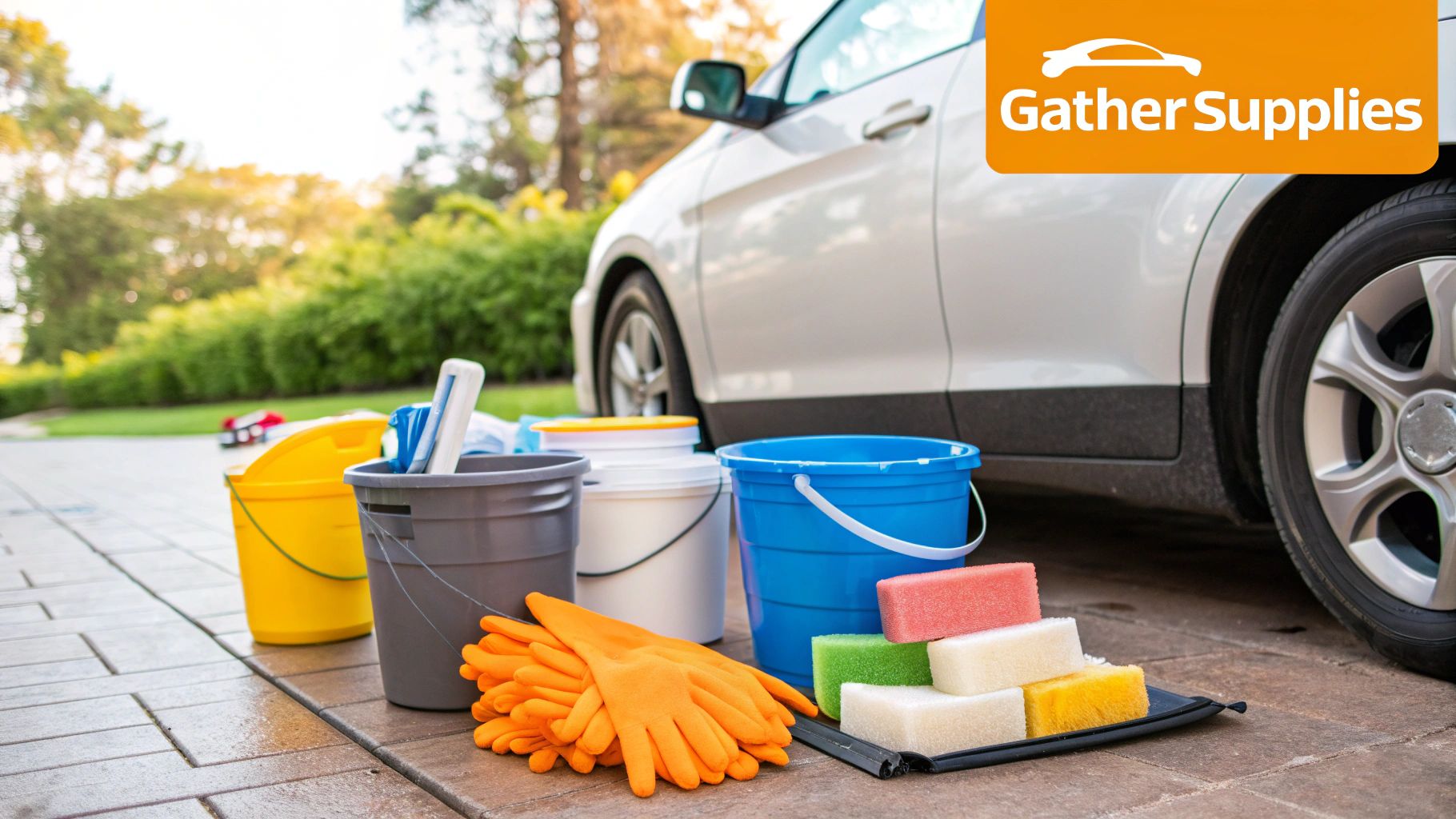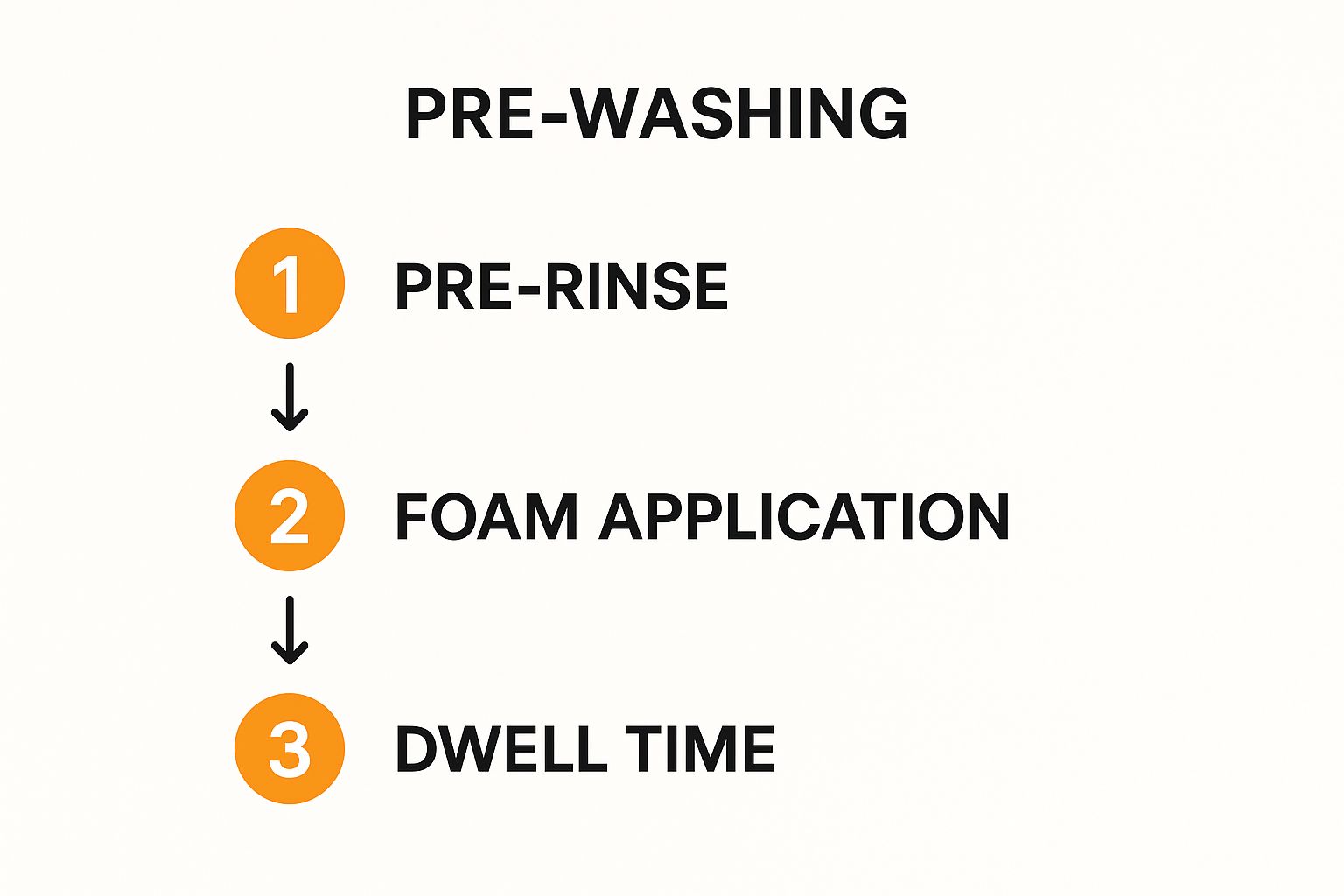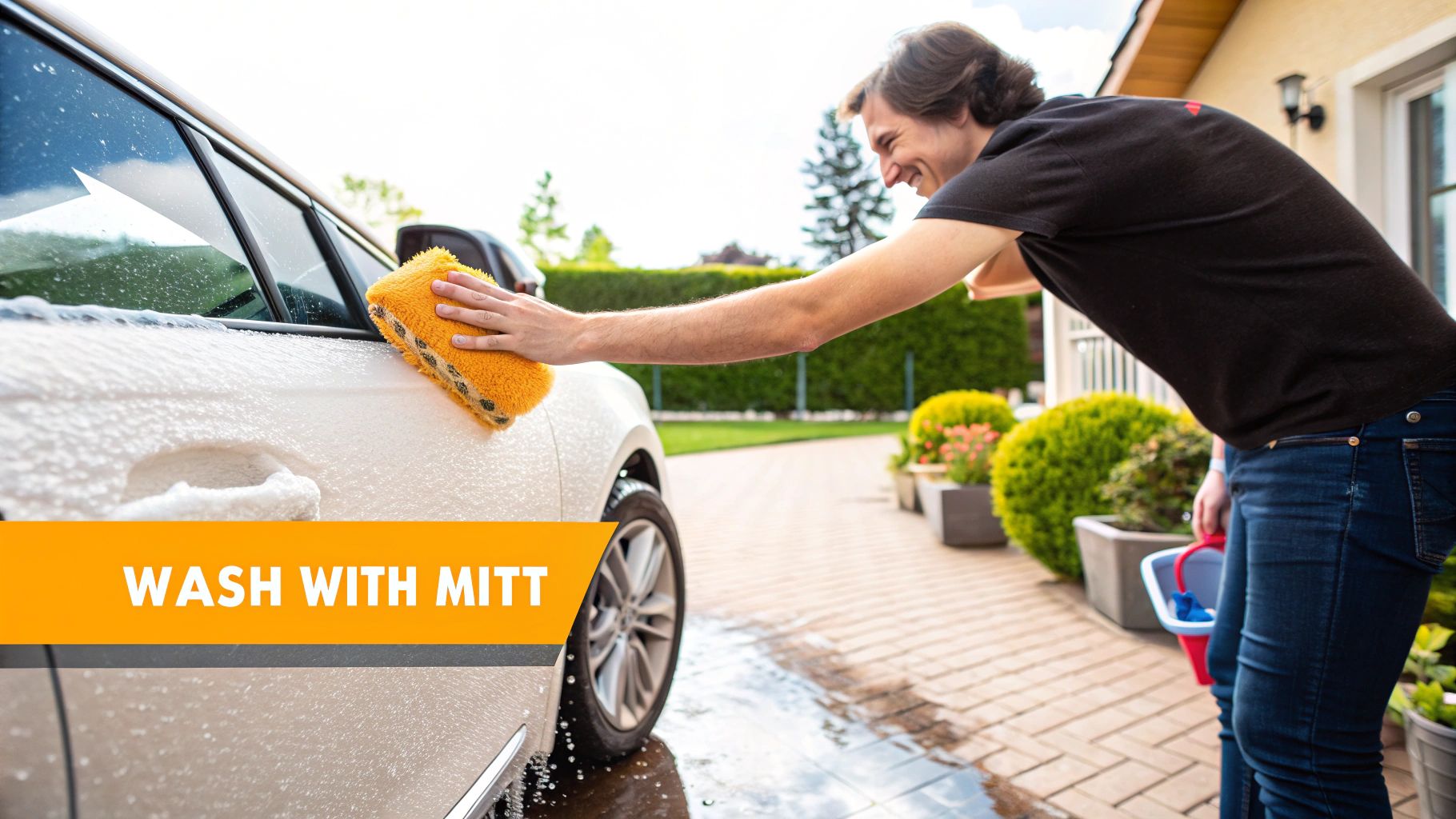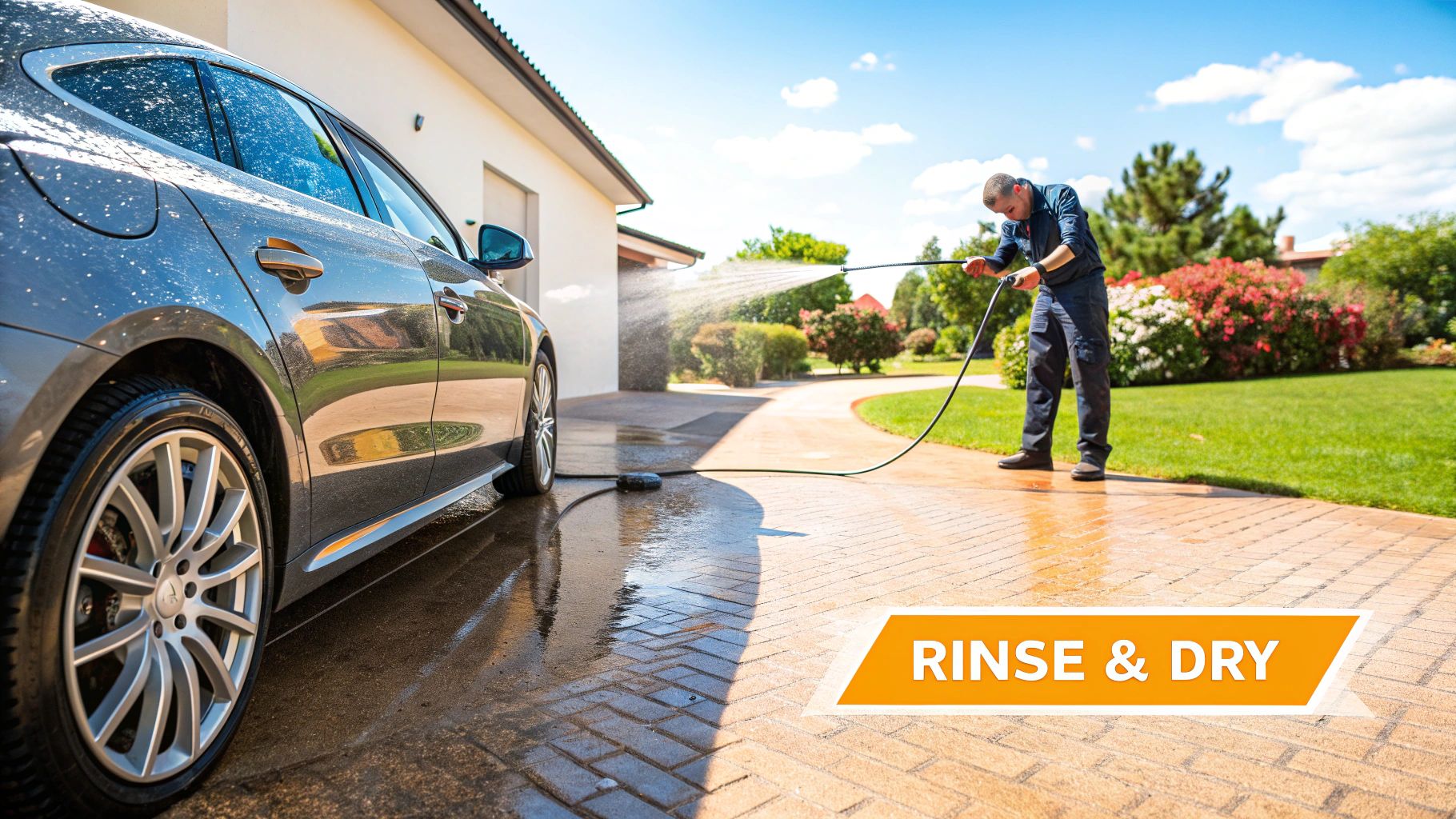Why Smart Car Owners Still Choose Home Washing
Professional car washes offer undeniable convenience. However, many car owners find distinct advantages in washing their cars at home. This hands-on method provides unmatched control over the process, allowing you to choose the best products and techniques for your vehicle's finish. For instance, selecting a pH-balanced car shampoo specifically designed for your car's paint can prevent damage that harsh chemicals at automated washes might inflict. This personalized care ensures a gentle yet effective clean.
Home washing also offers significant long-term cost savings. While a single professional wash might seem inexpensive, the costs add up over time. The yearly savings from washing at home can be substantial, allowing you to invest in premium car care products. This makes home washing an attractive option for budget-conscious owners.
Interestingly, the popularity of home car washing has shifted. While it was once the preferred method, the convenience of professional washes has led to a decline in DIY car care. In 1996, 52% of consumers preferred home washing. By 2023, that number decreased by 60%, with 89% of U.S. car owners now opting for professional services. Find more detailed statistics here. This shift reflects the time constraints many people face, making the speed of a professional wash more appealing.
Assessing the Fit for Your Lifestyle
Despite the convenience of professional car washes, washing at home remains a compelling choice. Deciding if it’s right for you depends on several factors: available time, local weather, and your car’s specific needs. It's comparable to choosing an exercise routine. Some prefer the structured environment of a gym, while others enjoy the flexibility of home workouts. Home car washing offers similar flexibility and control, allowing you to tailor the process to your schedule and preferences.
Debunking the Myths
Several misconceptions discourage people from washing their cars at home. One common myth is that home washing inevitably leads to swirl marks. However, with the right techniques and tools, like high-quality microfiber wash mitts and the two-bucket method, you can achieve a professional finish without damaging your paint. This means achieving stunning results right in your driveway is entirely possible. Another concern is water usage. However, using techniques like a SwiftJet Foam Cannon for efficient soap application can minimize water consumption while maximizing cleaning power.
Building Your Home Car Wash Arsenal That Actually Works

Getting a professional-looking car wash at home isn't about expensive equipment. It's about choosing the right supplies. This means focusing on quality products that protect your car’s finish and get the job done effectively. Using a pH-balanced car shampoo, for example, is vital for maintaining your paint’s health.
Essential Tools and Why They Matter
The two-bucket method is a perfect example of a simple yet highly effective technique. One bucket is for your soapy water, the other for rinsing. This keeps dirt from getting back onto your car, reducing swirl marks and scratches. The type of wash mitt you use is also crucial. Microfiber wash mitts are gentle and very good at picking up dirt.
Here are the key tools you’ll need:
- pH-Balanced Car Shampoo: Keeps your car's wax or sealant intact and prevents water spots.
- Two Buckets: Separating wash and rinse water minimizes swirl marks and scratches.
- Microfiber Wash Mitt: Lifts dirt gently without scratching your paint.
- Microfiber Drying Towels: Highly absorbent and soft, these minimize scratches and water spots when drying.
- Wheel Cleaner: Formulated to tackle brake dust and road grime.
- Spray Nozzle: Provides control over water pressure for effective rinsing. For more information, check out this helpful article: How to master pressure washing your car.
Choosing the Right Quality Level
Quality makes a difference with car washing tools, just like anything else. A cheap wash mitt might seem appealing, but it can create swirl marks that dull your car's finish. It's like using a dull knife; it works, but it takes more effort and the results aren’t as good. Investing in a high-quality drying towel, on the other hand, can cut drying time and reduce water spots.
Building Your Arsenal Strategically
You don't have to spend a fortune to build a great car wash kit. Begin with the essentials and add specialized tools as you need them. This gives you a chance to figure out the most effective way to wash your car at home. It’s like building a toolbox; you don’t need every tool right away.
The following table outlines the key tools and supplies, their purpose, recommended quality levels, and estimated costs.
Essential Car Washing Tools Comparison: Comparison of must-have tools, their purposes, and recommended quality levels for home car washing
| Tool/Supply | Purpose | Quality Level | Approximate Cost |
|---|---|---|---|
| Car Shampoo | Cleans the car safely | High | $10-$20 |
| Wash Mitts | Applies soap, lifts dirt | High | $10-$15 |
| Drying Towels | Dries the car without scratching | High | $15-$25 |
| Buckets (2) | Two-bucket wash method | Medium | $5-$10 |
| Wheel Cleaner | Cleans wheels effectively | Medium | $10-$15 |
| Spray Nozzle | Controls and directs water flow | Medium | $15-$25 |
As the table shows, prioritizing high-quality car shampoo, wash mitts, and drying towels contributes significantly to achieving a professional-level clean while protecting your car’s finish. Buckets, wheel cleaner, and a spray nozzle are important but opting for mid-range quality for these items can be a cost-effective choice.
By choosing the right tools and understanding how to use them, you can achieve professional-level results at home. Taking care of your equipment will ensure it lasts, keeping your car sparkling clean for years to come.
The Professional-Grade Washing Process You Can Master
This isn't your average car wash. We're exploring the detailed techniques used by professional detailers, adapted for your driveway. This process optimizes cleaning and prevents contamination, beginning with prepping your car and selecting the right location.
The Pre-Wash: The Foundation of a Flawless Finish
The pre-wash removes up to 70% of the dirt before you even touch the car with a wash mitt. This critical step minimizes the risk of scratching your paint during the main wash. This involves three key steps, visualized in the infographic below:

The infographic illustrates the pre-wash stages: a thorough pre-rinse followed by foam application and dwell time. This method ensures loose contaminants are removed before physical contact with the paint, significantly reducing potential scratches.
-
Pre-Rinse: Use a powerful stream of water from your SwiftJet Foam Cannon (without soap) to remove loose dirt, dust, and debris. This initial rinse is like sweeping before mopping, removing larger particles first for increased effectiveness in subsequent steps.
-
Foam Application: Apply a thick layer of car wash soap foam using your foam cannon. This tool helps the soap dwell on the surface, loosening grime and further minimizing scratch risks. The foam acts as a lubricant, helping dirt slide off easily.
-
Dwell Time: Let the foam sit for a few minutes to break down the dirt. Don't let it dry. This is similar to letting a cleaning solution soak into a stain. The longer it sits (within reason), the better it works.
The Main Wash: Gentle Yet Effective Cleaning
After the pre-wash, the main wash focuses on lifting remaining dirt using the two-bucket method. This technique prevents cross-contamination. Imagine cleaning a paintbrush in a single bucket—the paint would recontaminate the brush. The two-bucket method avoids this.
-
Washing: Use a quality microfiber wash mitt and work in straight lines, not circles, to prevent swirl marks, especially noticeable on darker cars. Rinse your mitt often in the rinse bucket.
-
Section by Section: Wash the car in sections, starting from the top down. This helps track progress and prevents soap from drying, especially in direct sunlight. It's methodical, ensuring full coverage.
The Rinse and Dry: The Finishing Touches
Rinsing and drying are the final steps. A thorough rinse removes all soap. Use a gentle stream and ensure no residue remains to prevent water spots and ensure a clean finish.
- Drying: Use quality microfiber drying towels. These are absorbent and gentle on your paint. Blot, don't wipe, to reduce scratching, especially crucial for cars with ceramic coatings or sealants.
By following this process, you can achieve a professional-level clean at home. Adapt the steps based on your car's condition and environment. Regular practice refines your technique, yielding consistent results and making your car shine.
Smart Water Use And Environmental Responsibility
Responsible car washing at home goes beyond simply having a clean car; it's about minimizing your impact on the environment. This involves being conscious of your water usage and selecting products that are environmentally friendly. Small changes to your routine can make a significant difference.
Optimizing Your Water Usage
Washing your car at home typically uses about 38 gallons of water, a figure comparable to professional car washes. However, professional washes often employ water recycling systems, which significantly reduces their overall water consumption. Find more detailed statistics here. Fortunately, there are several ways to reduce your environmental impact when washing your car at home. Choosing the right nozzle for your hose, for instance, can drastically reduce water waste. A concentrated stream is far more efficient than a wide spray. Think of it like using a watering can with a narrow spout versus pouring water from a bucket – the narrow spout delivers the water precisely where you need it.
Using efficient rinsing techniques can also help conserve water. Begin rinsing from the top of your car and allow gravity to assist in carrying the water and soap downwards. Timing also plays a crucial role. Avoid washing your car in direct sunlight, as this can cause the soap to dry quickly, necessitating more water for rinsing.
Choosing Eco-Friendly Products
Think about the environmental consequences of the products you use. Choose biodegradable car wash soaps that are phosphate-free. These soaps are less harmful to the environment and won't pollute local water systems. You might also be interested in learning more about waterless car washing options: How to master waterless car washing. Correctly disposing of wash water is equally important. Avoid letting it run into storm drains, which can carry pollutants directly into our rivers and streams.
Adapting to Local Regulations and Water Restrictions
Familiarize yourself with local regulations concerning car washing. Some regions implement restrictions during periods of drought. If you live in a water-restricted area, consider using a waterless car wash product or visiting a professional car wash that recycles its water. These alternatives ensure a clean car while conserving this valuable resource.
Seasonal Adjustments and Weather-Based Modifications
Adapt your car washing routine to the seasons. In winter, more frequent washes may be necessary to remove road salt, which can corrode your car's finish. During drier months, however, you can probably wash your car less often. Keeping an eye on the weather can also help optimize water usage. If rain is expected, postpone your car wash and let nature lend a hand. This saves water and aligns your routine with environmentally sound practices.

By incorporating these tips, you can maintain a sparkling clean car while being a responsible environmental steward.
Creating Your Personalized Washing Schedule

Generic advice often recommends washing your car every week or two. However, the most effective approach is to create a personalized schedule. Much like a fitness plan, your car wash routine should reflect your individual driving habits, environment, and how much you use your vehicle. This ensures your car stays clean without excessive effort.
Factors Influencing Your Wash Frequency
Several key factors determine how often you should wash your car. Consider your typical driving conditions. Someone commuting daily on highways will encounter significantly more dirt and grime than someone who only drives on weekends. Location also plays a significant role. Coastal areas expose cars to salt spray requiring more frequent washes, while desert climates contend with dust and pollen. Even personal preference influences washing frequency. Some car owners prioritize a spotless vehicle, while others are less concerned about a bit of dirt. Interestingly, studies show approximately 66% of U.S. car owners wash their vehicles one to two times per month. This statistic reflects a practical balance between cleanliness and convenience. Find more detailed statistics here. For a more in-depth guide, check out this resource: How often should you wash your car: complete care guide.
Seasonal Adjustments: Tailoring Your Schedule to the Elements
Seasonal changes also necessitate adjustments to your car wash routine. Winter road salt requires more frequent washes to prevent corrosion and protect your car's finish. Summer, with its dust and pollen, may also require more regular cleaning to maintain your car's shine. Just as you adapt your wardrobe to the weather, your car wash schedule should also change with the seasons.
Recognizing the Signs: When Does Your Car Really Need a Wash?
Knowing when your car genuinely needs a wash is vital for an effective schedule. A visible layer of dirt is the most obvious sign. However, a more subtle indicator is a gritty texture when you run your hand across the car's surface. This tactile test reveals accumulating dirt that could potentially scratch your paint, even if it isn't immediately visible. Similar to checking soil moisture before watering plants, your car might appear clean but still harbor a layer of grime you can feel.
Integrating Washing into Broader Vehicle Maintenance
Regular washing isn't just about appearances; it's an essential part of vehicle maintenance. It protects your car's paint, preserving its long-term condition and resale value. Much like regular dental checkups, consistent car washes contribute to the overall health of your vehicle. Moreover, if you've invested in protective coatings like wax or ceramic coatings, a consistent washing schedule maximizes their effectiveness, ensuring both cleanliness and ongoing protection. These coatings act as a shield for your car's paint, and regular washing keeps them working optimally. A personalized washing schedule ensures your car's cleanliness and significantly contributes to its long-term well-being.
Solving The Problems That Trip Up Most DIY Washers
Washing your car at home offers a sense of satisfaction, but a few common problems can make the process less enjoyable. Let's explore these issues and their solutions, ensuring your DIY car wash is always a success.
Tackling Stubborn Contaminants
Bird droppings, tree sap, and road tar can feel impossible to remove. With the right approach, however, you can conquer even the toughest grime. For dried bird droppings, soak the area with a detailer spray and let it sit. This softens the droppings, allowing for easier removal without scratching. Tree sap can be removed with a dedicated tree sap remover. Likewise, a tar remover can dissolve road tar, keeping your car’s finish pristine.
Dealing With Challenging Environmental Conditions
Washing in direct sunlight can cause water spots and soap streaks because the water evaporates too quickly. Work in sections, rinsing each immediately after washing. This prevents the soap from drying and leaving behind residue. Hard water can also leave mineral deposits. Using a water softener in your wash bucket can help, or you can dry your car immediately after rinsing. Just as gardening requires different approaches for different soil types, washing your car in varying conditions demands specific strategies.
Recovering From Washing Mistakes
Even with the best intentions, mistakes can occur. If you notice swirl marks or light scratches after washing, a car polish can often remove these imperfections. More serious damage from harsh cleaners might require professional help. Knowing when to call in an expert is key to preserving your car's finish.
Prevention is Key
Many car washing problems are preventable with proper techniques and products. A pH-balanced car shampoo helps protect your car's wax or sealant, reducing water spots. The two-bucket method, along with a quality microfiber wash mitt, is essential for preventing scratches. For an even better experience, a SwiftJet Foam Cannon creates a thick foam layer, allowing sufficient dwell time and preventing scratches. These preventive measures are like regular maintenance for your car, ensuring a smooth, problem-free experience.
To help you quickly identify and solve common car washing issues, the following table provides a handy reference guide for your at-home car washing routine.
Common Car Washing Problems And Solutions: Quick reference guide for identifying and solving frequent home car washing issues
| Problem | Cause | Solution | Prevention |
|---|---|---|---|
| Water Spots | Hard water, direct sunlight | Water softener, dry immediately | Using filtered water, washing in shade |
| Swirl Marks | Improper washing technique | Car polish | Two-bucket method, microfiber mitt |
| Soap Streaks | Soap drying too quickly | Rinse in sections | Wash in shade, work quickly |
| Bird Droppings | Dried bird excrement | Soak with detailer spray | Remove promptly |
| Tree Sap | Sticky residue | Tree sap remover | Avoid parking under trees |
| Road Tar | Tar clinging to paint | Tar remover | Regular washing |
By understanding these common car washing challenges and using the solutions and preventive measures outlined above, you can achieve professional-looking results every time you wash your car. This empowers you to maintain a sparkling clean car with confidence.
Key Takeaways For Consistent Home Washing Success
Mastering the art of washing your car at home involves understanding key principles and techniques. This section distills the most crucial points into actionable takeaways that will elevate your car washing experience. Think of it as a roadmap to achieving professional-grade results right in your driveway.
Quality Indicators of a Successful Wash
A truly successful home car wash goes beyond simply rinsing off dirt. It's about achieving a streak-free shine, a smooth, clean surface, and a protected finish. These qualities aren't just about appearances; they signify the care you invest in maintaining your vehicle. Streak-free windows, for example, indicate a thorough rinse and proper drying, demonstrating attention to detail. A smooth, clean paint surface shows the effectiveness of your pre-wash and wash process in removing dirt without scratching.
This underscores the importance of using quality tools and the right techniques.
Realistic Expectations and Skill Development
Home car washing, like any skill, requires practice. While immediate perfection isn't expected, gradual improvement should be the goal. Think of it like learning a new instrument – initial attempts might be rough, but consistent practice leads to proficiency. Understanding what you can realistically achieve with your current skills and equipment sets reasonable expectations. Consistent effort, combined with the right tools and techniques, will steadily improve your results. Over time, you'll see noticeable improvements in both your technique and your car’s finish.
Timing and Scheduling for Success
Washing your car shouldn't be a chore. Seamlessly integrating it into your routine is vital for consistent success. Develop a schedule that works for you, considering your driving habits, local weather, and the availability of natural light. Washing in the early morning or late afternoon, for example, prevents soap from drying too quickly and causing water spots, especially in warmer weather. This is particularly important during summer, when direct sunlight can quickly dry soap and leave residue. Just as athletes schedule training, integrating car washing into your routine improves consistency and results.
Checklist and Milestones for Consistent Results
A checklist helps ensure you don't miss essential steps in your washing routine. This can be a simple mental note or a detailed written guide – your personal car wash recipe. Setting milestones, such as consistently achieving a streak-free finish or mastering the two-bucket method, offers tangible markers of progress. These milestones become motivational checkpoints, reinforcing your growing car care expertise. They're not just about tracking progress; they're about celebrating the improvement in your skills and the satisfaction you gain from maintaining your vehicle.
Troubleshooting and Maintenance
Even with a perfect process, issues can still arise. Having readily available solutions for common problems like water spots or swirl marks is essential. Think of it as a first-aid kit for your car’s finish. Regularly maintaining your equipment, such as cleaning your foam cannon or wash mitts, ensures consistent performance and prevents contamination. This also prolongs the life of your tools, maximizing your investment. This proactive approach demonstrates a commitment to quality, ensuring optimal equipment function and an enjoyable car washing experience.
Ready to take your home car washing to the next level? The SwiftJet Car Wash Foam Gun helps you achieve professional results. Experience the difference a thick, clinging foam makes in lifting dirt and protecting your car’s finish. Check it out at SwiftJet and transform your car washing routine.
